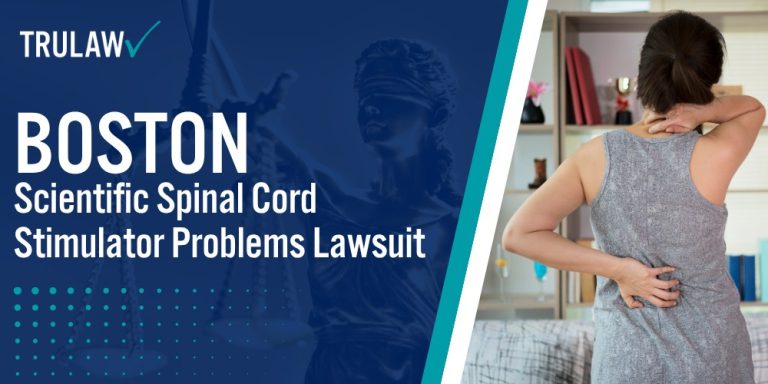Boston Scientific has developed multiple surgically implanted spinal cord stimulator (SCS) models designed to manage chronic pain through electrical impulses delivered to the spinal cord.
While these devices were intended to improve quality of life for patients suffering from intractable pain, numerous reports have emerged indicating serious complications affecting thousands of patients across the United States.
Common Boston Scientific SCS Models and Their Intended Functions
Boston Scientific’s spinal cord stimulator portfolio encompasses several key models:
- WaveWriter Alpha System: FDA approved in December 2020, this system features FAST (Field-Activated Smart Technology) therapy capabilities and offers both 16-contact and 32-contact options. The device provides paresthesia-based and sub-perception therapy modes, allowing physicians to customize treatment approaches based on patient response.
- Spectra WaveWriter System: This earlier-generation device combines multiple therapy options in a single platform, enabling what Boston Scientific calls “Combination Therapy.” The system allows simultaneous delivery of different waveforms to target various pain patterns.
- Precision System: Originally approved by the FDA in April 2004 under PMA P030017, this system has undergone numerous modifications through supplemental approvals. Unlike newer models, many Precision systems lack full-body MRI compatibility, limiting diagnostic options for implanted patients.
All three systems share common components including an implantable pulse generator (IPG), lead wires placed near the spinal cord to treat chronic pain, and a programmer for adjusting stimulation parameters.
Boston Scientific markets these devices as rechargeable or non-rechargeable options, with battery life expectations ranging from 3-25 years depending on usage patterns and model specifications.
According to FDA documentation, over 50,000 patients have been implanted with various Boston Scientific SCS models, though exact distribution numbers for each system remain proprietary.
How Boston Scientific Spinal Cord Stimulators Work
Spinal cord stimulators function by interrupting pain signals before they reach the brain through carefully calibrated electrical pulses.
The implantable pulse generator, typically placed under the skin in the lower back or abdomen, sends controlled electrical currents through insulated lead wires positioned in the epidural space near specific spinal cord segments.
Traditional paresthesia-based therapy creates a tingling sensation that masks pain and may reduce reliance on pain medications, while newer sub-perception modes deliver stimulation below the sensory threshold.
The implantation process proceeds through three stages, allowing patients to experience the full effects of the therapy before permanent placement:
- Trial Period: Medicare and most insurers require a 3-7 day trial stimulation period before permanent implantation. The National Institute of Neurological Disorders and Stroke recognizes this trial phase as standard practice to determine patient responsiveness. Success is typically defined by the physician as achieving at least 50% pain reduction.
- Surgical Implantation: Following a successful trial, patients undergo surgery with a qualified surgeon to place the permanent system. The procedure involves threading leads through the epidural space under fluoroscopic guidance and creating a pocket for the pulse generator.
- Programming and Adjustment: Post-implant programming sessions allow physicians to optimize stimulation parameters including frequency, amplitude, and pulse width to achieve optimal pain relief while minimizing side effects.
Clinical studies involving patients implanted between 2010 and 2021 have reported trial-to-permanent conversion rates increasing from 63.4% to 73.3%, suggesting improved patient selection criteria.
However, long-term effectiveness remains variable, with studies indicating 50-70% of patients maintaining meaningful pain relief at one year post-implant.
The WaveWriter Alpha’s MR Conditional designation permits full-body 1.5T MRI scans and ct scans when specific safety protocols are followed, addressing diagnostic imaging limitations of earlier models.
FDA Regulatory History and Approval Process
The regulatory pathway for Boston Scientific’s spinal cord stimulators has become a focal point of recent litigation, with allegations that the company exploited loopholes to avoid rigorous safety testing.
The Precision System received initial approval through the FDA’s Premarket Approval (PMA) process in 2004, theoretically subjecting it to the highest level of regulatory scrutiny.
However, subsequent modifications have raised serious concerns about patient safety.
Recent lawsuits filed in 2025 allege that Boston Scientific circumvented proper regulatory channels through the following methods:
- Expedited PMA Supplements: Rather than filing new PMAs for substantial design changes, the company allegedly used incremental supplements to introduce major modifications without comprehensive safety reviews. Court documents indicate over 300 supplements have been filed for the Precision system alone.
- 180-Day Supplements: These expedited review pathways, intended for minor changes, were allegedly used for alterations affecting device safety and efficacy. The FDA’s PMA database shows numerous supplements approved through shortened review periods.
- Avoiding Clinical Trials: By characterizing changes as minor modifications, Boston Scientific allegedly avoided conducting new clinical trials that might have identified safety issues before widespread distribution.
The Dena Lawler case, filed in May 2025, represents the first lawsuit naming both Boston Scientific and the FDA as defendants, arguing that the regulatory agency violated federal law by failing in its duty to protect patients through approving these incremental changes without adequate review.
This unprecedented legal action highlights growing concerns that the PMA supplement process has been manipulated to fast-track device modifications at the expense of patient safety, potentially affecting tens of thousands of implant recipients nationwide.
If you or a loved one experienced device malfunctions, inadequate pain relief, or required revision surgery after receiving a Boston Scientific spinal cord stimulator, you may be eligible to seek compensation.
Contact TruLaw using the chat on this page to receive an instant case evaluation and determine whether you qualify to join others in filing a Boston Scientific spinal cord stimulator lawsuit today.


